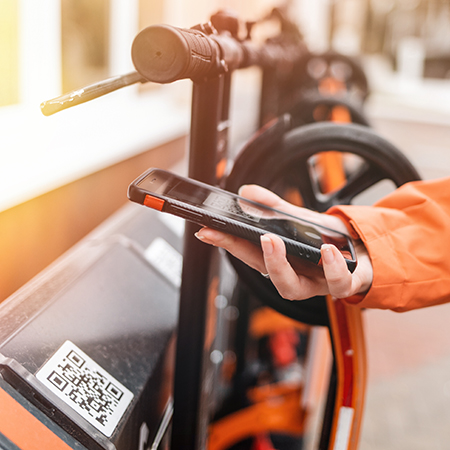 The connection between curb lane management and micromobility is a two-way street. As discussed throughout this series, parking management practices can be adopted to improve managing micromobility devices and flexible fleets along the curb. Conversely, curb lane management can benefit from innovative technologies brought to the curb by the advent of micromobility. One of these technologies is the use of quick response (QR) codes. To access micromobility devices, users scan QR codes using their cellphones, which unlocks the device. This approach of interconnecting mobility and technology has broader implications for the curb.
The connection between curb lane management and micromobility is a two-way street. As discussed throughout this series, parking management practices can be adopted to improve managing micromobility devices and flexible fleets along the curb. Conversely, curb lane management can benefit from innovative technologies brought to the curb by the advent of micromobility. One of these technologies is the use of quick response (QR) codes. To access micromobility devices, users scan QR codes using their cellphones, which unlocks the device. This approach of interconnecting mobility and technology has broader implications for the curb.
QR technology has been implemented by multiple industries as a part of the ongoing response to the COVID-19 pandemic. Restaurants have replaced physical menus with virtual menus accessed through QR codes. Retailers that have temporarily closed their brick-and-mortar locations have implemented QR code signage to allow customers to purchase goods online rather than in person. The use of QR codes has streamlined customer interactions and provided a novel opportunity for the curb.
This emerging technology can be integrated into curb lane management by placing QR codes on static street signs that allow pedestrians to access information about their environment. Through a combination of QR codes and GPS information, users can access location-specific information such as digital wayfinding and transportation asset maps. QR codes at transit stops can be used to take travelers to webpages that provide real-time arrival information and trip planning tools. Roadways that have planned improvements can use QR codes to help the public visualize roadway transformations through augmented reality, selecting their preferred roadway configuration through real-world preference surveys.
The use of QR coding also can help to improve transportation equity, access to micromobility devices, and address first/last mile connectivity. Smart meters, traditionally used to pay for parking, can serve multiple modes by adding QR codes to their printed receipts. Newer smart meters equipped with touch screens and app-based operating platforms can allow customers to select their mode of choice and pay for access to that mode. This technology creates an opportunity for the unbanked or people without cell phones to access micromobility options that were previously inaccessible.
The world of transportation and curb lane management is just at the beginning of exploring potential use cases for QR codes and will likely see continued implementation as cities connect the curb with emerging technology.
Read Part 1 and Part 2 and Part 3 of the series.
